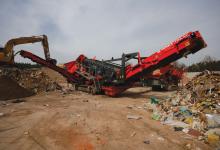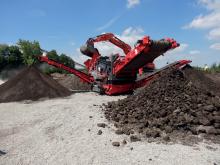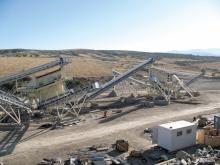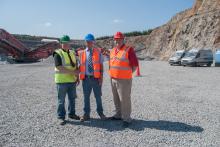A recycling depot just outside the Belgian capital Brussels saw
Terex Finlay has joined forces with German screen box constructor Spaleck to create the 883 Spaleck 3D Combi Flip-Flow screen.
A stepped top deck design, combined with Flip-Flow Elastica technology on the bottom deck, provides all-in-one processing and separation of recycling materials such as waste, recycling, shred metal, wood, compost, ores, coal, compost biomass and topsoil.
The 3D top deck is said to deliver maximum screening efficiency while increasing productivity, thanks to its anti-blockage design.
The 3D screen segments can be changed quickly thanks to their modular construction, and screen mats in the Flip-Flow screen are secured with a friction wedge, allowing a complete bottom deck change in around one hour.
The mobile plant has at its heart the two-deck high-performance Spaleck screen box: the 3D top deck design offers maximum screening efficiency while increasing productivity due to its anti-blockage design and the aggressive Flip-Flow bottom deck allows the machine to deal with material that previously could not be easily processed.
The first customer for the 883 Spaleck, de Vocht, part of the
The new unit is said to have a maximum throughput of 100m³/hour but it can be slowed down or speeded up to suit requirements.
Design engineer with Terex Finlay, Steven Aiken is part of the team responsible for the 883 Spaleck development.
“Two men can easily carry out a complete bottom deck change in less than one hour. The bottom deck has never blocked in situations ranging from slag, difficult steel, wet clay, and wet soil,” says Aiken
“The top deck 3D principle means that no hooked pieces of steel get stuck, so it does not snag any other material such as plastics and timber, and the tapered angle means that spikes and long pieces of timber and steel can’t get through.
“Changing the top deck is easy as each step is made up of four individual panels, with each panel weighing 40-50kg, which can be lifted by one or two people.
“It is also possible to mix and match with different size panels on the top and bottom to help spread the materials.”
Existing Terex Finlay 883s can be retrofitted with a complete Spaleck screen in 1-2 hours. The upgrade comes with box (top deck and bottom deck), drive system, hydraulic motor, mats, couplings and springs.
“This development opens up whole new opportunities for us,” says Terex Finlay.








